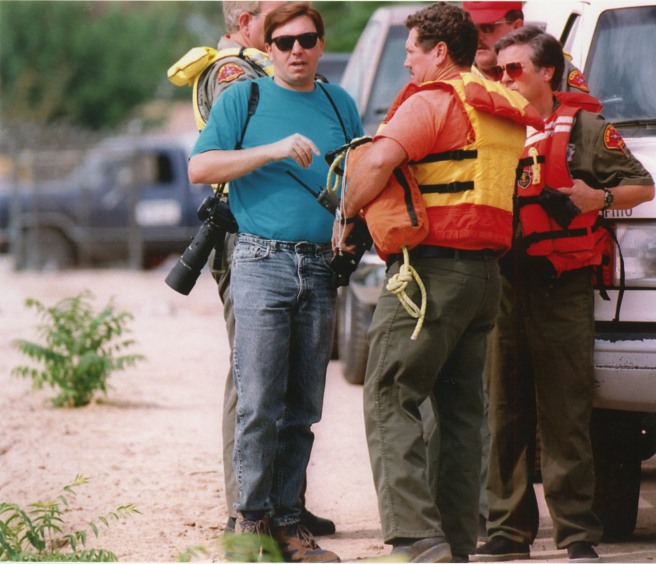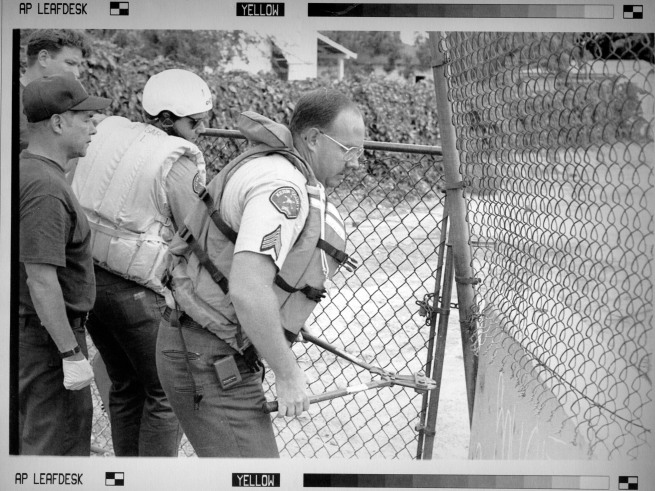 July 19, 1994. About 3 pm. I’m standing on a canal bank in south central Bakersfield, talking with some members of the Kern County Sheriff’s Department’s Search and Rescue team. They have been called, as have I, to this location for a report of a little boy who has disappeared in the canal’s waters. I don’t know it, but in about 10 minutes, I’m going to be arrested for the second time in my career. And that’s the nature of photojournalism, that’s how quickly a situation can turn on you. One minute you’re talking with deputies and officers you know. The next minute, one you don’t know shows up, decides you don’t belong there, and all hell breaks loose. And that’s what happened on this day.
July 19, 1994. About 3 pm. I’m standing on a canal bank in south central Bakersfield, talking with some members of the Kern County Sheriff’s Department’s Search and Rescue team. They have been called, as have I, to this location for a report of a little boy who has disappeared in the canal’s waters. I don’t know it, but in about 10 minutes, I’m going to be arrested for the second time in my career. And that’s the nature of photojournalism, that’s how quickly a situation can turn on you. One minute you’re talking with deputies and officers you know. The next minute, one you don’t know shows up, decides you don’t belong there, and all hell breaks loose. And that’s what happened on this day.
Interestingly, Henry Barrios has also come to the scene. I don’t notice as he snaps a picture of me talking to these guys. It turns out that that picture will become a crucial part of my defense. Notice the lens on my camera. It’s a 300 mm f4 Nikkor, and we’re going to be able to use it to blow away the sheriff’s and prosecutor’s contention that I was physically interfering with their efforts to put their boats in the water. That was the lie the prosecutor came up with. You can’t get on top of people with a 300 mm lens.
When the little boy’s body is seen floating at a different part of the canal, I arrive at the same time as authorities. They cut the gate, enter and begin the process of putting their boats in the water. I enter, too. My second camera contains a 50 mm lens, but I decide to head down the canal bank to shoot the boats going in with the 300. I am about 50 yards away, nowhere near any of the officers or boats, when a sheriff’s sergeant sees me and motions me to leave the canal bank. I initially ignore him. He yells and motions me toward him. I comply, and he tells me I can’t take pictures from that location. We argue. I ask him to explain why. He answers “because I said so.” Not good enough, I tell him. I ask him again, and he repeats “because I said so.” I tell him I’m going back to my spot. He says “do it and you’re going to jail.” I say, “well then take me to jail,” and I start to head back to the spot. He arrests me. It’s such a bullshit arrest that on the way to jail, the transporting officer, who was not the arresting officer, says, “I can’t believe he arrested you. You weren’t doing anything wrong. I’m sorry this happened.” Yeah, that much of a bullshit arrest. And how about this: when we were ready for trial and received the prosecution’s witness list, the arresting officer was not on it! Yeah, the prosecution was not even willing to put the guy who arrested me on the stand. That ought to speak volumes about him and his bogus arrest.
Henry Barrios would access the scene from a vantage point where there were not any deputies and would make a series of photos of the little boy being recovered. They were extremely graphic, and The Californian would decide not to publish them. And that’s how it’s supposed to work. The editors decide, not the cops. There’s no question in my mind this sergeant’s intent was singular – to prevent photos from being taken.

About a week later, I have my first meeting with my attorney, Stan Simrin. I walk into his office, and he says “I have good news for you.” I break into a grin. “Case dismissed,” I ask? After all, that’s what happened the first time I was arrested by KCSO, back in 1981. “No,” says Simrin. “This case isn’t going to get dismissed. (District Attorney Ed) Jagels is going to take this one all the way to the mat. You need to understand, Jagels hates The Californian. This is his opportunity to nail them. You really don’t matter. This is Jagels vs. The Californian, not Jagels vs. you. We’re going to win this case, but it could go all the way to the state supreme court. Are you ready for that?”
I tell him of course I am, and then ask “what’s the good news?” “The good news is I got the police report and it matches your report, almost exactly.” OK, I’m a little puzzled. Why is that good news? “Because there is no dispute about what happened. What you say happened and what the deputy says happened is the same. We do not have a he said, she said. A jury will not have to decide who is telling the truth, you or the deputy. Our case will be entirely about the law. Who was right within the law, you or the deputy?”
And, of course, I was. The case would wind through two courts and four judges, and take almost a year. Simrin was right about Jagels. When a municipal court judge refused to even allow the case to go to a jury and declared that I was not guilty and that the sheriff’s department was in the wrong (he said that!), Jagels appealed to superior court. There, a three judge panel ruled in my favor and rejected Jagels’ request to overrule the first judge and remand me for trial. It was the first case in California since the state supreme court’s ruling in Leiserson v. San Diego, which held that news media have an absolute right to access accident and disaster scenes, and it was Leiserson that the judges used to uphold the lower court.
Jagels did not appeal any further, and the case was over. The worst part of it for me was the fear of losing. Not because of jail – there was no way I would be sentenced to jail – but because of how it would have negatively impacted news photographers throughout the state. The case was being watched all over the state and even the nation, it received a lot of media coverage. But that didn’t happen. The Leiserson ruling held, the judges got it right, and Jagels would never “get” another chance at The Californian.
